Icosahedral 120-cell
In geometry, the icosahedral 120-cell, polyicosahedron, faceted 600-cell or icosaplex is a regular star 4-polytope with Schläfli symbol {3,5,5/2}. It is one of 10 regular Schläfli-Hess polytopes.
| Icosahedral 120-cell | |
|---|---|
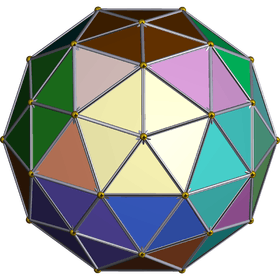 Orthogonal projection | |
| Type | Schläfli-Hess polytope |
| Cells | 120 {3,5} |
| Faces | 1200 {3} |
| Edges | 720 |
| Vertices | 120 |
| Vertex figure | {5,5/2} |
| Schläfli symbol | {3,5,5/2} |
| Symmetry group | H4, [3,3,5] |
| Coxeter-Dynkin diagram | |
| Dual | Small stellated 120-cell |
| Properties | Regular |
It is constructed by 5 icosahedra around each edge in a pentagrammic figure. The vertex figure is a great dodecahedron.
Related polytopes
It has the same edge arrangement as the 600-cell, grand 120-cell and great 120-cell, and shares its vertices with all other Schläfli–Hess 4-polytopes except the great grand stellated 120-cell (another stellation of the 120-cell).
| H4 | - | F4 |
|---|---|---|
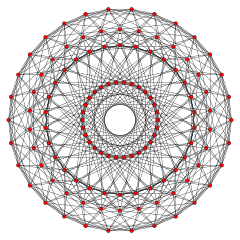 [30] |
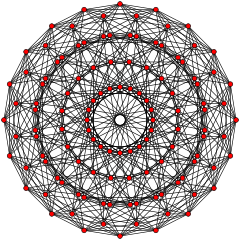 [20] |
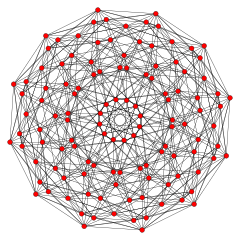 [12] |
| H3 | A2 / B3 / D4 | A3 / B2 |
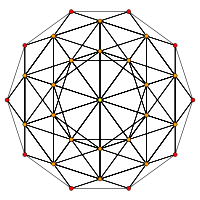 [10] |
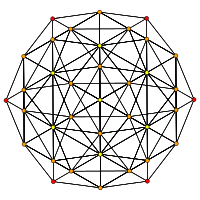 [6] |
 [4] |
As a faceted 600-cell, replacing the simplicial cells of the 600-cell with icosahedral pentagonal polytope cells, it could be seen as a four-dimensional analogue of the great dodecahedron, which replaces the triangular faces of the icosahedron with pentagonal faces. Indeed, the icosahedral 120-cell is dual to the small stellated 120-cell, which could be taken as a 4D analogue of the small stellated dodecahedron, dual of the great dodecahedron. With its dual, it can form the compound of icosahedral 120-cell and small stellated 120-cell.
See also
- List of regular polytopes
- Convex regular 4-polytope
- Kepler-Poinsot solids - regular star polyhedron
- Star polygon - regular star polygons
References
- Edmund Hess, (1883) Einleitung in die Lehre von der Kugelteilung mit besonderer Berücksichtigung ihrer Anwendung auf die Theorie der Gleichflächigen und der gleicheckigen Polyeder .
- H. S. M. Coxeter, Regular Polytopes, 3rd. ed., Dover Publications, 1973. ISBN 0-486-61480-8.
- John H. Conway, Heidi Burgiel, Chaim Goodman-Strass, The Symmetries of Things 2008, ISBN 978-1-56881-220-5 (Chapter 26, Regular Star-polytopes, pp. 404–408)
- Klitzing, Richard. "4D uniform polytopes (polychora) x3o5o5/2o - fix".